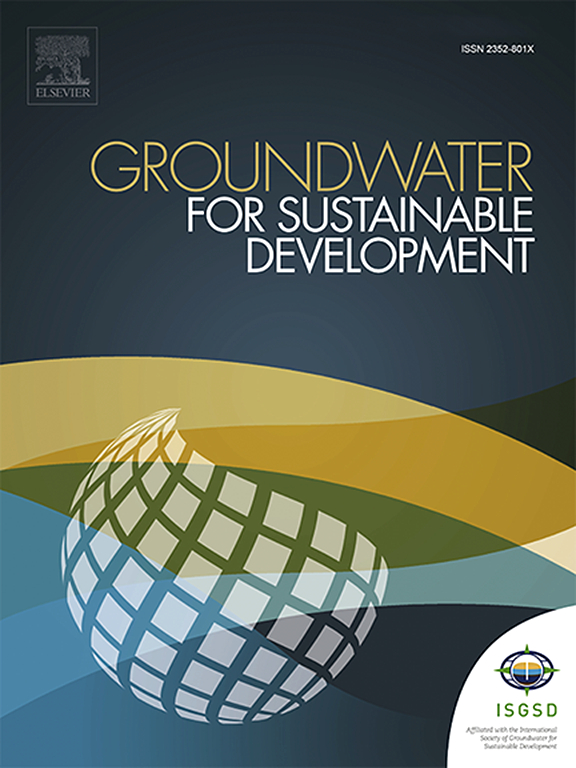Hydrogeochemical evolution of spring water in the western lower himalayas: Seasonal changes, quality assessment, and health risks
IF 4.9
Q2 ENGINEERING, ENVIRONMENTAL
引用次数: 0
Abstract
Spring water serves as a vital freshwater source for Himalayan mountain communities. In order to determine the spring water quality, hydrogeochemical processes, and seasonal changes, thirty-six samples from nine locations in four seasons (2021–2023) were collected and analysed for physicochemical constituents, heavy metals, and stable isotopes (δ18O and δ2H). The findings demonstrate that a mixture of processes, such as silicate and carbonate weathering through ion exchange and reverse ion exchange processes, regulate the spring water chemistry. The geochemical evolution of spring water is primarily driven by rock weathering, with 86% of the samples exhibiting a Ca.Mg-HCO3 water type. Most parameters show insignificant seasonal changes except for SiO2 (p = 0.002), Al (p = 0.007), Co (p = 0.002), Cu (p = 0.00), Li (p = 0.00), Mo (p = 0.00), and Pb (p = 0.00). The isotopic data suggests meteoric origin of spring water, with δ18O and δ2H values ranging from −8.91‰ to −7.65‰ and −62.7‰ to −51.6‰ (pre-monsoon) and −9.71‰ to −7.86‰ and −63.9‰ to −51.3‰ (post-monsoon), aligning with the local meteoric water line (δ2H = 7.73 × δ18O+10.45; r2 = 0.99). The EWQI and HPI suggest excellent spring water quality in 89%–100% of samples. Among the heavy metals, arsenic poses a potential non-carcinogenic risk in 11%–44% of spring water samples for adults and children. Similarly, arsenic (33%–56%) and nickel (44%–78%) present significant carcinogenic risks, exceeding the acceptable limit of 1 × 10−4. Overall, the spring water quality is adequate and primarily driven by natural processes, but the levels of As and Ni are in the critical range for human health.

喜玛拉雅山西部下游泉水的水文地球化学演化:季节变化、水质评价和健康风险
泉水是喜马拉雅山区重要的淡水来源。为了确定春水水质、水文地球化学过程和季节变化,在4个季节(2021-2023)采集了9个地点的36个样品,并对其理化成分、重金属和稳定同位素(δ18O和δ2H)进行了分析。研究结果表明,通过离子交换和反向离子交换过程的硅酸盐和碳酸盐风化等混合过程调节了泉水的化学性质。泉水的地球化学演化主要受岩石风化作用驱动,86%的样品表现为Ca.Mg-HCO3水型。除SiO2 (p = 0.002)、Al (p = 0.007)、Co (p = 0.002)、Cu (p = 0.00)、Li (p = 0.00)、Mo (p = 0.00)和Pb (p = 0.00)外,其余参数的季节变化不显著。同位素数据表明,泉水来源于大气,δ18O和δ2H值在- 8.91‰~ - 7.65‰和- 62.7‰~ - 51.6‰(季风前)和- 9.71‰~ - 7.86‰和- 63.9‰~ - 51.3‰(季风后),与当地大气水线一致(δ2H = 7.73 × δ18O+10.45;r2 = 0.99)。EWQI和HPI表明89%-100%的样品水质优良。在重金属中,砷在11%-44%的成人和儿童泉水样本中具有潜在的非致癌风险。同样,砷(33%-56%)和镍(44%-78%)具有显著的致癌风险,超过了1 × 10−4的可接受限度。总体而言,泉水水质良好,主要受自然过程驱动,但砷和镍含量处于对人体健康至关重要的范围。
本文章由计算机程序翻译,如有差异,请以英文原文为准。
求助全文
约1分钟内获得全文
求助全文
来源期刊

Groundwater for Sustainable Development
Social Sciences-Geography, Planning and Development
CiteScore
11.50
自引率
10.20%
发文量
152
期刊介绍:
Groundwater for Sustainable Development is directed to different stakeholders and professionals, including government and non-governmental organizations, international funding agencies, universities, public water institutions, public health and other public/private sector professionals, and other relevant institutions. It is aimed at professionals, academics and students in the fields of disciplines such as: groundwater and its connection to surface hydrology and environment, soil sciences, engineering, ecology, microbiology, atmospheric sciences, analytical chemistry, hydro-engineering, water technology, environmental ethics, economics, public health, policy, as well as social sciences, legal disciplines, or any other area connected with water issues. The objectives of this journal are to facilitate: • The improvement of effective and sustainable management of water resources across the globe. • The improvement of human access to groundwater resources in adequate quantity and good quality. • The meeting of the increasing demand for drinking and irrigation water needed for food security to contribute to a social and economically sound human development. • The creation of a global inter- and multidisciplinary platform and forum to improve our understanding of groundwater resources and to advocate their effective and sustainable management and protection against contamination. • Interdisciplinary information exchange and to stimulate scientific research in the fields of groundwater related sciences and social and health sciences required to achieve the United Nations Millennium Development Goals for sustainable development.
 求助内容:
求助内容: 应助结果提醒方式:
应助结果提醒方式:


